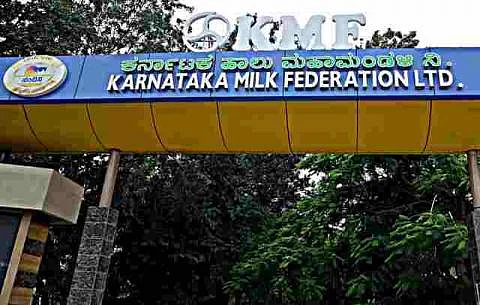

The Karnataka Milk Federation's (KMF) current position is a classic case of setting targets with little thought to the consequences. In 2011, KMF had set a target of achieving 65 lakh litres per day in 2015, which is now realized, but the federation now has to rack its brains to find a market for the high milk surplus, which has also put a financial strain on the federation.
Karnataka has been a milk surplus state since the formation of the KMF in 1980s, but due to incentives to dairy farmers, the procurement rate has gone up. Until 2008, the procurement rate was growing annually at 5 percent, but this shot up to 11 per cent when the government offered Rs 2 per litre an incentive. In May this year, the government announced an additional incentive of Rs. 2, raising the procurement rate to 14 percent.
Today, KMF procures an average of 65 lakh litres of milk every day from dairy farmers, which is more than double the quantity of 2008.
While it is increasingly becoming difficult to utilize the milk, the KMF also has a remarkable achievement: the milk procured on a single day is either consumed within the state, converted into milk powder or into milk that has a long shelf life.
Cause for increase in milk production
KMF’s Managing Director SN Jayaram says that the government’s incentive was one of the reasons for surplus milk production. “People are shifting from agriculture to dairy farming because they get a good price for milk, one of the reasons being incentive. They also feel that the prices are stable, which assures them of getting return on their investment. Also since direct payment is being made to them, there is no involvement of middlemen,” he says.
A dairy farmer in the state is paid Rs 25-27 for each litre of milk that is procured. This, he claims, is the highest in the country.
What happens to all the milk?
Of the average of 60-65 lakh litres of milk procured every day, the daily consumption of liquid milk in the state is 35-40 lakh litres. The remaining 20-25 lakh is converted to skimmed and whole milk powder, Jayaram says.
The four conversion plants in the state can only convert about 10 lakh litres into milk powder, necessitating another 10 lakh litres of liquid milk to be sent to neighbouring states like Maharashtra, Andhra Pradesh and Tamil Nadu.
The remaining liquid milk (around 15 lakh litres) is converted to Ultra-Heat Treatment (UHT) milk which has a shelf life of three-six months, unlike the ordinary packaged milk which has a shelf life of only 24 hours.
The UHT is sent to 17 states, including north-eastern region, Jammu and Kashmir. Because of its long shelf-life, UHT milk is purchased by the armed forces, says Jayaram.
How packaged milk is produced
KMF is the top-most run of a three tier-organization. The smallest unit are 13,000 Milk Co-operative Societies with a combined membership of 23 lakh dairy farmers. These societies are governed by 14 Milk Unions.
Milk sold by a dairy farmer is sent to a Bulk Milk Cooler (BMC) in the local milk cooperative society (or milk chilling centre) where it is stored at temperature of 4 degree Celsius. From here, the milk is sent to dairy centres where processing including pasteurisation is done. Next, it is packed and sold to retailers and consumers. There are 43 milk chilling centres and 23 such dairy processing centres in the state.
Problems faced
Although there is no wastage, KMF has been unable to sell the UHT milk as there is no demand. “Since milk production has gone up in the country and in the world, people prefer drinking fresh milk to converted form or stored form. Even export of milk powder has gone down,” says Jayaram.
The cost of producing milk powder is Rs 240-250 per kilogram, where as the market price is Rs 140, which is stretching KMF’s financial resources.
Jayaram says that because of the huge stock, there has been delays in payment to the farmers; which KMF is tackling by taking commercial loans.
KMF can overcome this “financial stress” as there have been decreased rains in some states. “Decreased rains mean less milk production and more demand for milk powder. Slowly the milk prices may go up and we can recover the costs,” he says.
Solution
KMF is relying on government’s help to effectively utilise the surplus production of milk. It has sent a proposal to extend the ‘Ksheera Bhagya’ programme from three days a week at present to five days. Under this programme, milk is given to children from Class I to 10 and also in anganwadis. This, Jayaram says, is a win-win situation for children and for KMF to ensure that the excess stock is fully used.
They are also looking at converting excess milk into UHT format, UHT-flexi format (shelf life of one month) as it allows storage of surplus milk. “If you are not able to sell that milk in 24 hours, increase the shelf life to one month, three months or six months, so that you are able to create the demand for milk and sell the excess. That is the solution,” he says.
But there is problem with that too: as people are not used to either consuming or storing milk for, KMF needs to create a market for it. currently, its only customers are the armed forces.